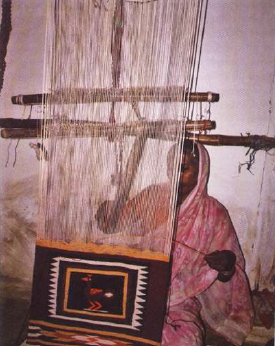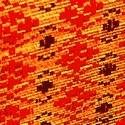
Dhurries, Floor Covering, Carpets, Textiles, Weaving, Spinning, Khadi, Wool, Felt
Navalgund Dhurrie Weaving / Floor Covering of Dharwar, Karnataka
Navalgund a small town in the Dharwar district is where the most colourful dhurries are woven. Earlier it was a weaving centre for woollen carpets but as wool became more expensive there was a switch to cotton dhurrie weaving. The motifs remain the same, and geometrical and floral designs abound. Navalgund dhurries are characterised by unusual patterns and stunning colours. Although these are cotton dhurries, yet the bright and lustrous colours used make them look far from ordinary.
The art of dhurrie weaving has been passed down from one generation to the next. Families guard craft techniques even from their own daughters (who do not practise the craft). However, attempts are being made to introduce production on a more efficient and regular basis.
A special dhurrie called sutada is made in Bijapur and Dharwar districts of Karnataka. This has simple, horizontal stripes of different colours. In Mulgund and Murgao of Dharwar district, a special dhurrie is made by joining together various nine-inch pieces of coloured cloth. Inspiration for the motifs is derived from wall paintings and wooden miniatures. Special designs are made for festive occasions.
The origin of Navalgund dhurries can be traced back to the tumultuous times of the sixteenth-century Bijapur, where Jamkhana weavers sought refuge in Navalgund amid the power struggles between the Deccan Sultanate and the Vijayanagara Empire. Their migration was not just a physical move but a commitment to safeguarding their craft, ensuring its continuity for generations.
Navalgund Dhurries are woven using a unique vertical loom called Khadav Magga, and their designs are a visual feast of geometric patterns. The weavers skillfully incorporate motifs such as Badi Ghari (Diamond with a double edge), Nanhi Ghari (diamond with a single edge), Laheri (wave), Phul (flower), Bhell (zigzag), Chinda (vertical stripe), Chunnat (twill diamond), Mor/Navilu (peacock), Dhara (horizontal stripes), and Pagadi Aata (Indian traditional dice game). The designs are not just ornamental; they reflect the town’s essence, with peacock motifs paying homage to Navalgund’s name, meaning ‘Hill of Peacocks.’
Crafted with precision, the warp of Navalgund Dhurries consists mainly of unbleached cotton yarn, creating a sturdy foundation for the vibrant weft yarns in yellow, red, blue, and green. The durability and beauty of these dhurries lie in the meticulous combination of materials and the weavers’ expert hands.
The crafting process involves using various tools, each serving a crucial role. The Panja/Beater, a fork-like iron device, aids in inserting yarns, while a metal rod ensures the even insertion of yarn into the vertical threads. The Tibni, a pointed wooden tool, guides the weft yarn into the warp, and a knife (Chaku) is employed to cut off excess or unwanted yarn. These tools are instruments and extensions of the weavers’ dedication and skill.
Gallery
YOUR VIEWS
PRACTITIONERS: INDIA
Access 70,000+ practitioners in 2500+ crafts across India.
BIBLIOGRAPHY
10,000+ listings on arts, crafts, design, heritage, culture etc.
GLOSSARY
Rich and often unfamiliar vocabulary of crafts and textiles.
SHOP at India InCH
Needs to be written.





